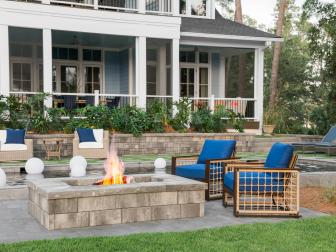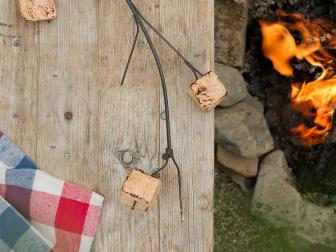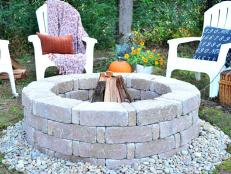10 Essential Outdoor Fire Pit Safety Rules
Keep your family safe by knowing the safety rules for gas or wood-burning outdoor fires. Plus, learn about the best fire pit tools, tips for having a fire pit on a deck or under a pergola, and what type of wood to burn in a fire pit.
Nothing lights up the night like the dancing flames of a fire pit. Savoring the smell of wood smoke or watching gas-powered flames lick lava rock — these are the moments that help you unwind and make memories that last a lifetime.
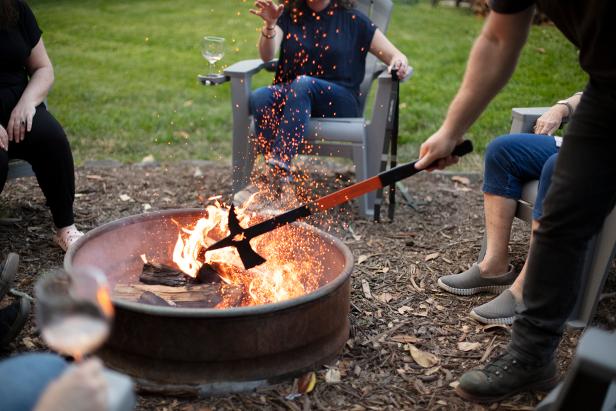
PitCommand.com
When using a fire pit ring, make sure your tools are long enough to reach into the fire. This three-in-one tool includes an axe-like chopper, serrated hook and poker. Carbon steel construction makes it lightweight, while a long handle keeps hands out of the fire.
Whether you’re in the market for a custom fire pit, a DIY fire pit you can tackle with your family or just want to warm up your patio with the special cozy that a fire pit brings, it’s important to understand basic fire pit safety rules before you light your first blaze. Stay safe at your outdoor fire pit by following these simple practices.
Where to Put a Fire Pit?
One of the most important decisions to make about fire pit safety is determining where to place a fire pit. Choose a level spot, especially with portable fire pits or fire bowls. Ideally, a fire pit should be at least 10 feet away from any structures — 20 feet is even better. This includes your house, shed, fence and neighboring yards.
Check the area around and above your fire pit. You don’t want any plants within 10 feet of the fire pit area. Trim overhanging branches that could become a fire risk, especially with stray sparks from a wood-burning fire pit. Surround your fire pit with non-combustible materials, like crushed stone, brick or sand. It’s best to remove any vegetation, even lawn.
Gorgeous Fire Pit Ideas and DIYs 60 Photos
Looking to add some elemental excitement to your outdoor space? Consider these cozy, stylish blazes a warmup for your own toasty conversation starter.
Check Your Local Fire Pit Codes
Review all local city, county or HOA rules related to fire pits and make sure yours will be up to code. Some communities require a permit for a permanent fire pit, while others demand an on-site inspection by local fire officials.
You might discover stipulations regarding smoke pollution, which can rule out a traditional wood-burning fire pit. In that case, choose a smokeless wood-burning fire pit or a gas fire pit. Other city and county codes forbid open flames on a wooden deck.
Some municipalities define distances that must be observed for nearby seating, planting or structures. In some communities, these rules are law. Do your homework and make sure you’re in compliance.

PitCommand.com
Local fire stations often sponsor fire pit safety programs, where they share tips on building a fire pit, deck-safe fire pits and local rules for backyard fires.
Check Your Homeowner's Insurance
It’s a good idea to check in with your insurance agent to ensure that you have the proper coverage in the event of some type of fire damage. In wildfire-prone areas, the law might require that you disclose a fire pit to your insurance company.
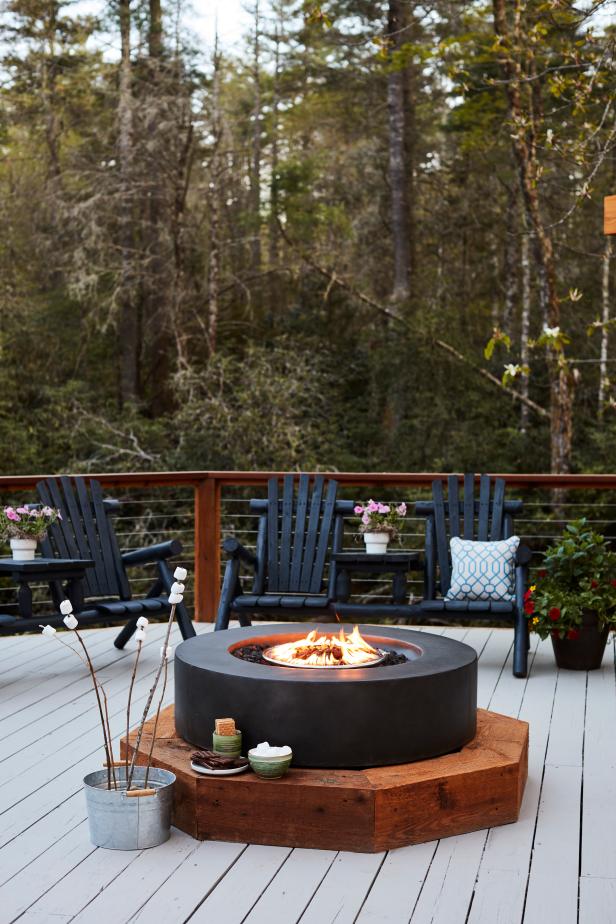
David A. Land
This deck fire pit with a clean and modern look connects to the home’s propane system and serves as a versatile heating source for one of the deck’s seating areas.
Can You Put a Fire Pit on a Deck?
To use a fire pit on a deck, start by placing it at least 10 feet away from anything flammable, including furniture, cushions, roof overhangs and deck rails. Next, create a fire pit safety base, an area for the fire pit to sit on that’s not flammable. Buy a fire pit pad designed to protect deck surfaces, or DIY a pad using pavers, stone, bricks or metal.
The pad should extend at least 24 inches beyond the fire pit in all directions. Make sure your deck can handle the weight of the fire pit and pad. Never place your fire pit directly on a fire pit pad or the deck surface. Always use the stand that comes with the fire pit.
The ideal deck-safe fire pit should have an ash catch tray. Fire bowls or fire pits supported by sturdy legs fit this bill, as do most fire pits with ash drawers. In general, the best deck-safe fire pit is a pedestal style, with legs that keep the hot basin off the deck.
For wood-burning fire pits, choose a model with a spark screen, or invest in a spark screen. Keep the screen closed to prevent embers and sparks from blowing out of the fire.
Add a layer of sand to the bottom of your fire pit before lighting a fire. That sand adds another insulating layer between your fire pit and the deck. It will also help prolong the quality and effectiveness of your fire pit pad.

A spark screen helps keep embers and sparks from billowing out of a wood-burning fire pit or bowl. If your fire pit doesn't come with a spark screen, check with the pit manufacturer to see if you can buy one that fits. Otherwise, look to fire pit supply companies for a custom-fit spark screen.
Can You Put a Fire Pit Under a Pergola?
You can use a fire pit under a pergola safely as long as you have proper ventilation. A pergola is typically open-sided, so there should be adequate airflow to prevent any carbon monoxide issues.
A gas-fueled fire pit (propane or natural gas) is usually considered the best choice for under a pergola. A gas fire pit burns cleaner and is smokeless. With a wood-burning fire pit, over time the smoke may discolor the pergola “ceiling,” and soot will accumulate on surfaces. Definitely use a spark screen with a wood-burning fire pit under a pergola.
If the pergola “ceiling” is too low, any type of fire pit can result in trapped heat that can eventually crack or char paint or beams.

Warwick P Hunt
Built-in seating surrounds three sides of a modern fire pit, creating a cozy spot for relaxing and talking with friends. A pergola overhead defines the seating area and adds to its friendly, welcoming feel.
What Type of Wood Should be Burned in a Fire Pit?
Wood falls into two categories: hardwood or softwood. Hardwood is typically denser and burns longer. Examples include oaks, hickory, madrone, locust, walnut, maple and fruit trees. Hardwood can be more difficult to ignite, but once it burns, it produces glowing coals that release heat over time.
Softwood tends to burn very quickly, very hot and with a high flame. Softwoods typically contain moisture pockets that pop and explode when heated, throwing sparks. Examples include pines, fir, cedars, redwood, hemlock and birch. Kindling is usually softwood because it ignites quickly.
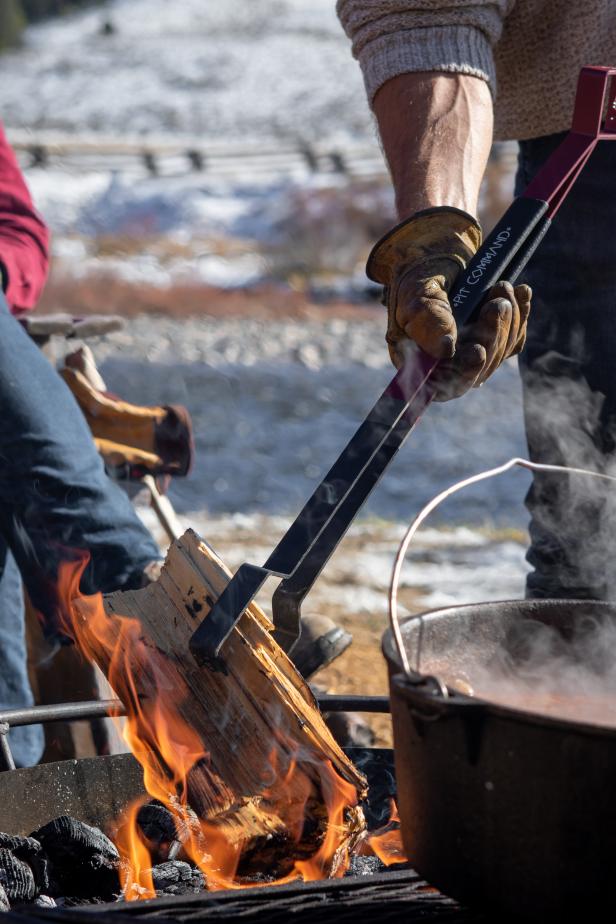
PitCommand.com
Fire pit safety includes choosing the right tools to tend your blaze. Finesse log placement with long-handled grabbers that let you grasp logs firmly, keeping your arms safely away from the roaring flames.
Gas Fire Pit Safety
A gas fire pit burns cleaner, and many consider it safer than a wood-burning fire pit. Even so, it’s important to follow safety rules for gas pits. Always inspect your fire pit before using it. Check the burner and keep it free from any obstructions.
Cover your gas fire pit when it’s not in use. A cover excludes rain, which can damage porous and ceramic logs in a gas fire pit. Without a cover, insects and spiders can crawl in and actually clog the burner. Clean the burner periodically according to manufacturer instructions, usually with a soft, clean brush or cloth.
Avoid cooking in your gas fire pit — that includes marshmallow roasting. A melting, drippy marshmallow can clog a burner. The only time it’s safe to cook on a gas fire pit is when it’s designed for cooking.
Always turn off the gas when the fire pit isn’t in use. Closing the gas line ensures that the pit can’t be ignited accidentally. It also eliminates any potential gas leaks. When buying a gas fire pit, choose one where the gas line is easily accessible.
When you’re done with a gas-fueled fire, turn off the burner and close the gas valve. Wait for the fire pit contents (glass, rocks, ceramic logs, etc.) to cool off before leaving the fire pit.
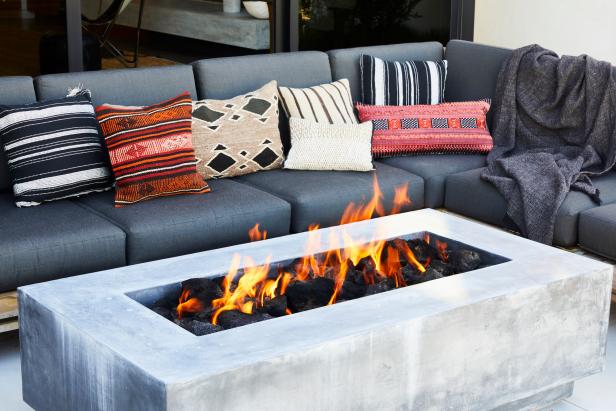
Nicole Franzen
A gas-powered fire pit can often be safer and easier to use than a wood-burning fire pit.
Before You Light the Fire: 10 Fire Pit Safety Rules
1. Check the Weather
Avoid lighting your fire pit during windy conditions. A light breeze is fine, but strong winds can carry sparks, creating potential fire hazards. If air quality is poor or at an alert level, burning wood isn’t a great idea at that time.
2. Create a Buffer
Place your fire pit on a level spot at least 10 feet away from surrounding structures or neighboring yards.
3. Prepare for Emergencies
Despite taking all safety precautions, accidents can — and do — occur. Keep a first aid kit handy, along with a fully charged fire extinguisher, bucket of water and/or garden hose.
4. Inspect the Fire Pit
Before building a fire, look over your fire pit. Are there any rust spots or thin areas that might burn through? On gas fire pits, are burners unclogged and free of debris?
5. Keep Kids and Pets Away
As a rule, have children and pets maintain a 3-foot perimeter around a fire pit. The Journal of Burn Care Research (Nov. 30, 2020) reported that nearly 50% of pediatric burns from outdoor fires resulted from a fall into a fire pit, bonfire or campfire. Supervise kids at all times around a fire pit.
6. Contain the Flames
Use a spark screen on your fire pit, especially with wood-burning models on a deck.
7. Stay With the Fire
Don’t leave your fire unattended. With a gas fire pit, always turn the gas line off before leaving the space.
8. Use Good Tools
Choose long-handled tools with insulated, stay-cool handles to maneuver logs in the fire pit. Avoid overloading the fire pit with fuel. Too many logs can lead to bonfire-size flames.
9. Provide Light
Add lighting to your yard to help keep friends and family from tripping. Subtle, soft string lights won’t detract from the mood of the fire.
10. Put Out the Fire
Have a plan to extinguish your fire. Do not head inside and let it die down unattended. With a metal fire pit bowl, avoid dousing the fire with water, which can shorten the life of the pit by leading to rust. Some fire pits come with a cover or snuffer that cuts off oxygen to the fire so it dies. Or you can extinguish a fire with dry sand or dirt.







